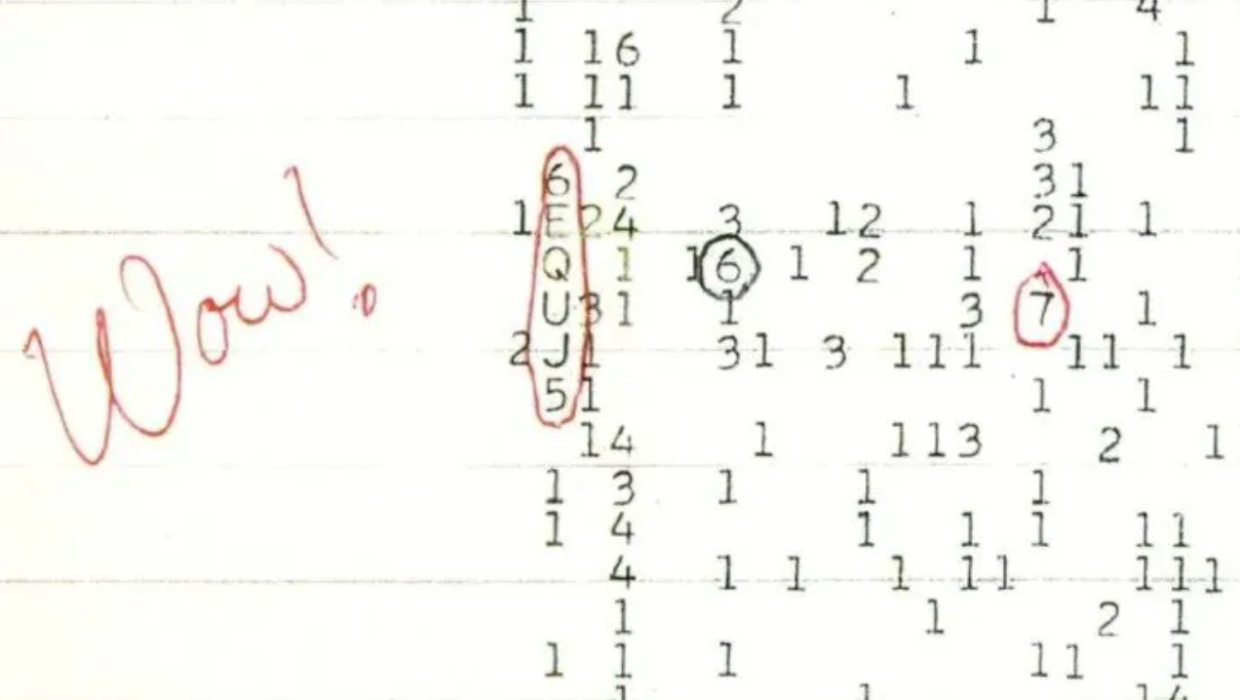Science
Scientists Pinpoint 1977 Alien Signal’s Likely Natural Cause

A radio signal detected in 1977, once considered a potential sign of extraterrestrial life, has likely been traced back to a natural source, according to recent research by scientists. The signal, known as the “Wow! signal,” was captured by the Big Ear radio telescope at Ohio State University on August 15 of that year. Its distinctive frequency of 1.42 GHz drew significant attention, leading to decades of speculation about its origins.
Scientists from the University of California, Berkeley, have conducted a comprehensive analysis of the signal, which had remained a mystery for over four decades. Jerry R. Ehman, who originally discovered the signal, famously circled it on the printout and wrote “Wow!” next to it, prompting widespread interest in potential extraterrestrial communications.
The recent findings suggest that the Wow! signal is likely the result of natural astrophysical phenomena. Researchers focused on the frequency and temporal characteristics of the signal, comparing it with known cosmic sources. Their analysis indicates that the signal may have originated from a hydrogen cloud, which is consistent with a natural source rather than an artificial one.
Decades of Speculation Finally Addressed
For years, the Wow! signal has fueled debates within the scientific community and among enthusiasts of the Search for Extraterrestrial Intelligence (SETI). Despite numerous attempts to detect a repeat of the signal, none have been successful, further deepening the enigma surrounding its origin.
The excitement surrounding the initial detection led to various theories, ranging from the mundane to the extraordinary. While some speculated it was evidence of alien life, others cautioned that the signal might be attributed to terrestrial interference or natural cosmic events. The latest research aligns with the latter, providing a clearer understanding of this decades-old mystery.
According to the researchers, the signal’s characteristics match those of several known astrophysical phenomena, such as pulsars or other cosmic radio emissions. These findings help to demystify one of the most intriguing signals in radio astronomy, yet they do not diminish the fascination surrounding the quest for extraterrestrial life.
Implications for Future Research
The implications of this research extend beyond the Wow! signal itself. As scientists continue to explore the cosmos for signs of life, distinguishing between natural and artificial signals becomes increasingly vital. This study provides a methodological framework for analyzing similar signals in the future.
Moreover, the research highlights the importance of continuing advancements in observational technology and techniques. With new telescopes and instruments coming online, the search for extraterrestrial signals is more robust than ever. The scientific community remains committed to understanding the universe, driven by the hope that one day definitive evidence of extraterrestrial life may be discovered.
In conclusion, while the Wow! signal may have lost some of its mystery, it serves as a reminder of humanity’s enduring curiosity about the universe. The latest findings not only clarify this particular signal’s origin but also pave the way for future explorations into the unknown.
-

 World4 months ago
World4 months agoTest Your Knowledge: Take the Herald’s Afternoon Quiz Today
-

 Sports4 months ago
Sports4 months agoPM Faces Backlash from Fans During Netball Trophy Ceremony
-

 Lifestyle4 months ago
Lifestyle4 months agoDunedin Designers Win Top Award at Hokonui Fashion Event
-

 Entertainment4 months ago
Entertainment4 months agoExperience the Excitement of ‘Chief of War’ in Oʻahu
-

 Sports4 months ago
Sports4 months agoLiam Lawson Launches New Era for Racing Bulls with Strong Start
-

 World5 months ago
World5 months agoCoalition Forms to Preserve Māori Wards in Hawke’s Bay
-

 Health4 months ago
Health4 months agoWalking Faster Offers Major Health Benefits for Older Adults
-

 Lifestyle4 months ago
Lifestyle4 months agoDisney Fan Reveals Dress Code Tips for Park Visitors
-

 Politics4 months ago
Politics4 months agoScots Rally with Humor and Music to Protest Trump’s Visit
-

 Top Stories5 months ago
Top Stories5 months agoUK and India Finalize Trade Deal to Boost Economic Ties
-

 Health2 months ago
Health2 months agoRadio Host Jay-Jay Feeney’s Partner Secures Visa to Stay in NZ
-

 World5 months ago
World5 months agoHuntly Begins Water Pipe Flushing to Resolve Brown Water Issue









